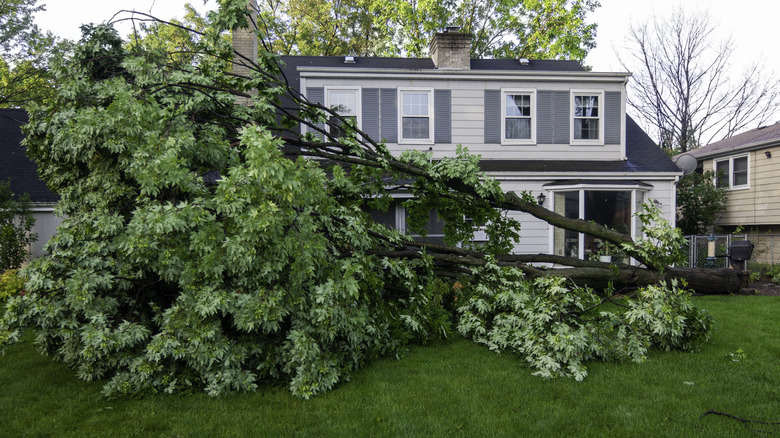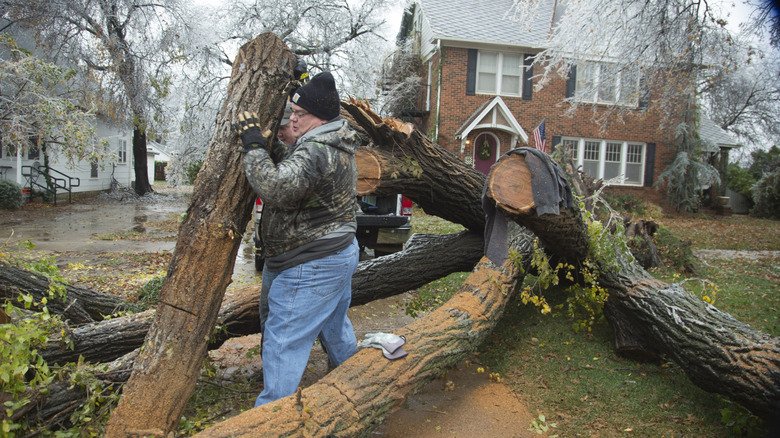Who Is Responsible For Storm Damage Tree Removal?
You've heard that old adage, "If a tree falls in the woods, does it make a sound?" But what about when a tree falls on your neighbor's house? Or yours? With severe weather events becoming all too common, you may be wondering who is responsible for storm damage caused by falling trees. If you're lucky, storm damage may be limited to a large tree limb that pokes through a new roof. It's far worse when a trunk gets entirely uprooted as the result of soggy ground only to crush an entire wing of a house. According to Your Lovable Lawyer Danny Karon, although homeowner's insurance typically covers the cost of tree removal, you'll need to be familiar with your specific homeowner's insurance policy to find out exactly what kind of storm damage is and isn't covered.
"Typically, homeowner's insurance covers tree removal but only if the tree damages a covered structure or blocks access to a driveway," Karon tells House Digest during an exclusive interview. "That said, coverage varies by policy, so you need to read your policy." The attorney says calling your insurance agent is the fastest way to find out if your home insurance covers storm damage. They can also help you file a claim, although Karon also recommends filing "through an insurance company's app." You'll need to take detailed pictures to document the damage, and may want the advice of an arborist to assess the repair or removal of a fallen tree. But no matter how good your coverage, trimming large limbs and unruly branches, and getting rid of any dead or diseased trees before bad weather rolls in, are smart storm prep tips to minimize costly damage.
Removal costs get complicated if tree damage isn't covered by insurance
According to Danny Karon, things get a little more complicated if storm damage tree removal isn't covered by homeowner's insurance. "Generally, the responsibility for tree removal falls on the property owner where the tree lands," he explains in his exclusive interview with House Digest. "So if the tree lands on your property, it's your responsibility to remove it." The attorney notes that this is especially the case when a tree on your property is damaged on your own property.
You may be surprised to find yourself responsible for the removal of a tree that's fallen on your property, "even if the tree originated on a neighbor's property," Karon says. In that event, he recommends talking to your neighbor about splitting the cost of its removal. "Or if the tree was visibly diseased or dead before the storm and fell due to the neighbor's negligence, they may be responsible for damages and removal costs." It's a good idea to keep an eye out for fungal growth and leaf spots — easy ways to identify a diseased tree in your yard — to make sure you don't leave yourself open to the same liability. Tree removal costs vary widely and can range from $200 for shorter varieties like a Japanese maple to $10,000 for a towering pine tree.
Leave tree removal to the professionals
Despite the expense, whether your insurance will cover tree removal after a major storm or not, you should not attempt to do it yourself. "Removing fallen trees is dangerous, and homeowners should hire a professional tree service to do it," Danny Karon recommends to House Digest exclusively. One time to keep this in mind is when a tree on your property is damaged and falls on a road or public land, or vice versa. "Generally, if a tree falls on the street, the city or municipality is responsible for the cleanup because they are typically responsible for maintaining public roadways," he explains. "But, again, if the tree fell due to your negligence (e.g., you knew it was diseased, and you didn't address it), you could be held liable."
If you're anxious to avoid the hassle of tree removal after a storm altogether, there are some ways to ensure your trees are safe and healthy. Frequently walk around your property, taking note of any trees that are starting to lean or show signs of soil erosion or softening around the roots. Remove dangling tree branches that are likely to snap during strong winds, rainstorms, or under the weight of snow or ice. Split or cracked trunks are signs its time to call a tree surgeon, because this can weaken a tree from the inside out, making it far more likely to fall in the future.


